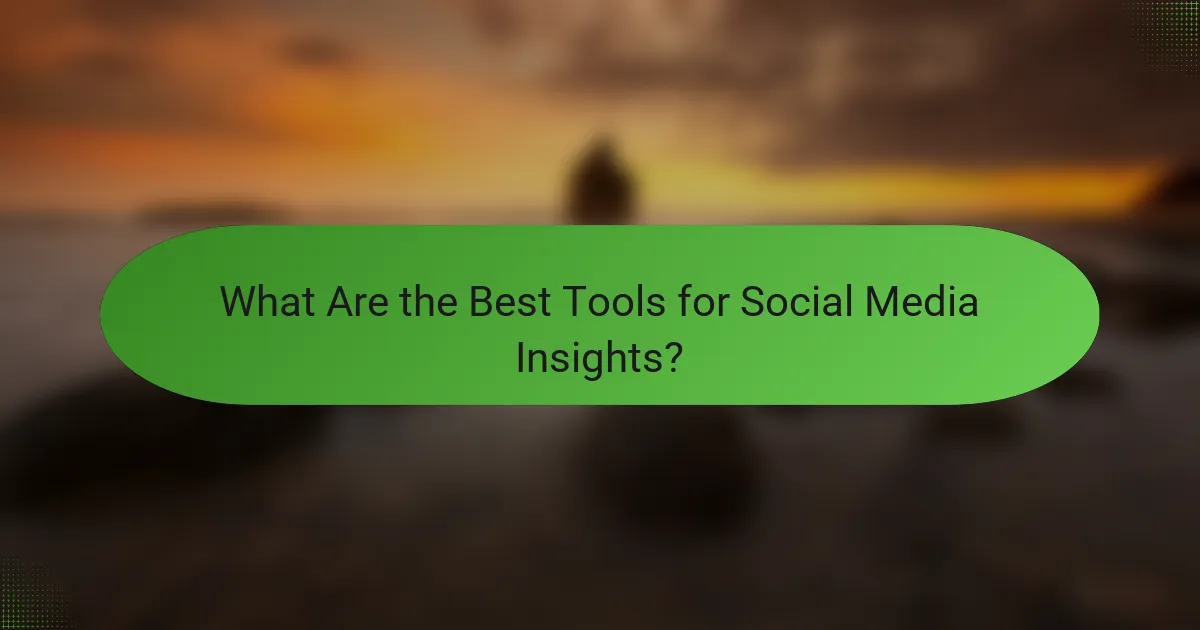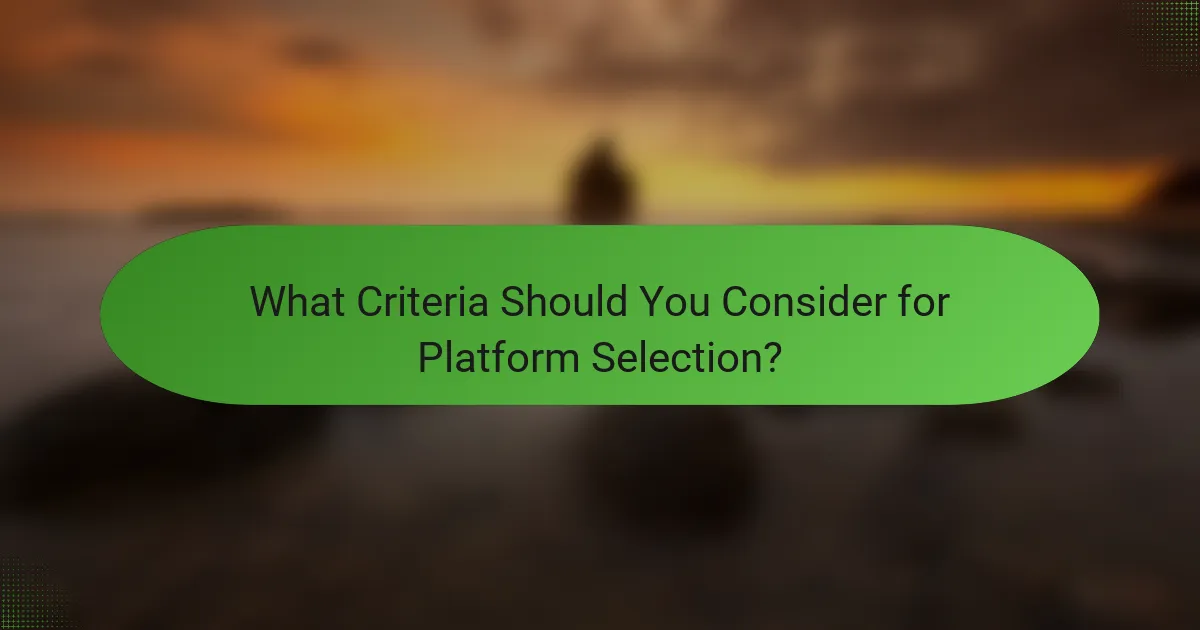In today’s digital landscape, crafting a robust social media strategy is essential for brands aiming to connect with their target audience effectively. By identifying clear objectives and selecting the right platforms, businesses can enhance engagement and foster meaningful interactions. Additionally, tracking key metrics such as follower count and engagement rates is crucial for understanding audience growth and behavior, enabling continuous improvement in social media efforts.

How to Develop a Social Media Strategy?
To develop a social media strategy, identify your objectives, target audience, and the platforms that best suit your goals. A well-defined strategy guides your content creation and engagement efforts, ensuring you reach the right people effectively.
Define target audience
Understanding your target audience is crucial for effective social media engagement. Start by creating buyer personas that detail demographics, interests, and online behaviors. This helps tailor your content to resonate with specific groups.
Consider using surveys or analytics tools to gather data about your audience. Look for trends in age, location, and preferences to refine your approach.
Set measurable goals
Setting measurable goals allows you to track the success of your social media efforts. Use the SMART criteria—specific, measurable, achievable, relevant, and time-bound—to define your objectives.
Examples of measurable goals include increasing followers by a certain percentage within six months or boosting engagement rates by a specific amount. Regularly review and adjust these goals based on performance data.
Choose appropriate platforms
Selecting the right social media platforms is essential for reaching your target audience. Research where your audience spends their time; for instance, younger demographics may prefer TikTok or Instagram, while professionals might be more active on LinkedIn.
Each platform has its unique features and audience expectations, so tailor your content accordingly. Focus on 2-3 platforms to start, rather than spreading yourself too thin across many.
Create a content calendar
A content calendar helps organize your posts and maintain consistency. Plan your content in advance, including themes, formats, and posting schedules. This ensures a steady flow of relevant content that aligns with your goals.
Consider using tools like Google Calendar or dedicated social media management software to streamline this process. Regularly review and adjust your calendar based on audience engagement and feedback.
Analyze competitors
Analyzing competitors provides insights into effective strategies and potential gaps in the market. Identify key competitors in your niche and evaluate their social media presence, content types, and engagement levels.
Look for patterns in their successful posts and audience interactions. Use this information to inform your strategy, but ensure your content remains unique and authentic to your brand.

What Are Effective Engagement Techniques?
Effective engagement techniques are strategies that foster interaction and connection between brands and their audiences on social media. These methods can significantly enhance audience participation, loyalty, and overall growth.
Utilize interactive content
Interactive content, such as polls, quizzes, and surveys, encourages active participation from users. This type of content not only captures attention but also provides valuable insights into audience preferences and behaviors.
Consider incorporating tools like Instagram Stories polls or Facebook quizzes to engage your audience. These formats can boost engagement rates significantly, often exceeding traditional post interactions.
Respond to audience feedback
Responding to audience feedback shows that you value their opinions and fosters a sense of community. Engaging with comments, messages, and reviews can enhance relationships and encourage further interaction.
Make it a practice to acknowledge both positive and negative feedback promptly. This responsiveness can lead to higher trust levels and increased loyalty among your followers.
Host live sessions
Live sessions, such as Q&As or product launches, create real-time engagement opportunities. They allow audiences to interact directly with your brand, ask questions, and receive immediate responses.
Platforms like Facebook Live or Instagram Live can be effective for hosting these sessions. Aim for a regular schedule to build anticipation and ensure consistent audience turnout.
Leverage user-generated content
User-generated content (UGC) involves sharing content created by your audience, such as photos or testimonials. This not only showcases your community but also builds authenticity around your brand.
Encourage followers to share their experiences with your products or services using specific hashtags. Highlighting UGC can enhance engagement and create a sense of belonging among your audience.

How to Measure Audience Growth?
Measuring audience growth involves tracking various metrics that indicate how your social media following is expanding over time. Key indicators include follower count, engagement rates, reach, and impressions, all of which provide insights into your audience’s behavior and preferences.
Track follower count
Monitoring your follower count is the most straightforward way to gauge audience growth. Regularly check the number of followers across your social media platforms to identify trends, such as spikes during specific campaigns or content types.
Consider setting benchmarks for growth, such as aiming for a percentage increase monthly. For instance, a growth rate of 5-10% per month is often seen as healthy in many industries.
Analyze engagement rates
Engagement rates reflect how actively your audience interacts with your content, which is crucial for understanding growth. Calculate engagement by dividing the total interactions (likes, comments, shares) by your follower count, then multiply by 100 to get a percentage.
A high engagement rate, typically above 1-3%, indicates that your content resonates well with your audience. Focus on creating quality content that encourages interaction to boost these rates.
Monitor reach and impressions
Reach refers to the total number of unique users who see your content, while impressions indicate how many times your content is displayed, regardless of clicks. Tracking these metrics helps you understand how effectively your content is being distributed.
Use tools to monitor these metrics over time, aiming for a steady increase. A good practice is to compare your reach and impressions against your follower growth to assess whether your audience is expanding beyond just your followers.
Use analytics tools
Utilizing analytics tools can streamline the process of measuring audience growth. Platforms like Google Analytics, Facebook Insights, and Instagram Analytics provide detailed reports on follower count, engagement, reach, and more.
Choose tools that align with your social media strategy and budget. Many platforms offer free versions with essential features, while paid options provide deeper insights and advanced functionalities to enhance your audience growth analysis.

What Are the Best Tools for Social Media Insights?
The best tools for social media insights help businesses analyze performance, engage audiences, and grow their following. Key options include Hootsuite, Sprout Social, and BuzzSumo, each offering unique features tailored to specific needs.
Hootsuite for scheduling
Hootsuite is a leading platform for scheduling social media posts across various channels. It allows users to plan content in advance, ensuring consistent engagement with audiences at optimal times.
When using Hootsuite, take advantage of its bulk scheduling feature, which enables you to upload multiple posts simultaneously. This can save time and streamline your content calendar.
Be cautious of scheduling too far in advance, as trends can shift quickly. Regularly review and adjust your scheduled posts to stay relevant and engaging.
Sprout Social for analytics
Sprout Social excels in providing in-depth analytics that help businesses understand their social media performance. It offers insights into audience engagement, post reach, and overall effectiveness of campaigns.
Utilize Sprout Social’s reporting features to track key metrics over time. This can help identify successful strategies and areas needing improvement, allowing for data-driven decision-making.
Consider setting benchmarks based on industry standards to evaluate your performance accurately. Regularly analyze your data to adapt your strategy and optimize engagement.
BuzzSumo for content research
BuzzSumo is a powerful tool for content research, enabling users to discover trending topics and popular content within their niche. This can inform your content strategy and help generate ideas that resonate with your audience.
Use BuzzSumo to analyze what types of content perform best on different platforms. This insight can guide your content creation efforts, ensuring you focus on formats and subjects that attract attention.
Be mindful of the competition; regularly check what similar brands are sharing. This can help you identify gaps in the market and opportunities to differentiate your content.

What Criteria Should You Consider for Platform Selection?
When selecting a social media platform, consider your target audience, content type, and engagement goals. Each platform has unique demographics and features that can significantly impact your strategy and audience growth.
Audience Demographics
Understanding audience demographics is crucial for effective platform selection. Different platforms attract varying age groups, interests, and behaviors. For instance, Instagram is popular among younger users, while Facebook has a broader age range.
Analyze your target audience’s preferences and habits to determine where they spend their time online. Tools like Google Analytics or social media insights can provide valuable data on user demographics.
Content Type
The type of content you plan to share should influence your platform choice. Visual content, such as images and videos, performs well on platforms like Instagram and TikTok, while text-heavy content may be better suited for Twitter or LinkedIn.
Consider creating a content calendar that aligns with the strengths of each platform. This can help you maximize engagement by tailoring your content to fit the platform’s unique characteristics.
Engagement Features
Different platforms offer various engagement features that can enhance audience interaction. For example, Instagram Stories allow for real-time engagement, while Facebook Groups foster community discussions.
Evaluate which features are most relevant to your goals. If building a community is a priority, platforms with group functionalities may be more beneficial than those focused solely on broadcasting content.
Advertising Options
Advertising capabilities vary significantly across platforms, affecting your reach and budget. Facebook and Instagram provide robust advertising tools with detailed targeting options, while platforms like TikTok may offer more limited but creative ad formats.
Assess your advertising budget and objectives when choosing a platform. Consider starting with a small budget to test different ad formats and audiences before scaling your efforts.
Platform Trends and Longevity
Stay informed about current trends and the longevity of social media platforms. Some platforms may experience rapid growth, while others could decline in popularity. For example, TikTok has surged in popularity, while platforms like MySpace have faded.
Regularly review industry reports and social media trends to ensure your strategy remains relevant. Adapting to changes can help maintain your audience engagement and growth over time.
